2 Key Points Your Craft Show Display Must Convey
Craft shows have been levelling up since I sold at my first one in 2005.
They’re in bigger venues, attracting bigger crowds, and are better organized, branded, and marketed.
Craft show vendors are no longer crafters making random items and seeing if they can earn a few extra bucks.
They’re business owners focused on profits and creating professional-looking displays, well-crafted products, and thoughtfully planned product lines.
Craft shows are competitive and you need to bring your A-game.
To attract shoppers and optimize sales, you should be able to answer the following two questions, and clearly communicate them to craft show shoppers.
What you make & Why you make it
There was a reason you started your business right? You’re not simply making soap, or jewelry, or art because you’re capable of doing so.
You started your business because you knew you could offer something better or different than what’s out there.
That reason is the story behind what you do.
And it matters to shoppers, so your craft show display must communicate that message.
Through your product selection (and with the help of props, signage, sales pitch, etc.), your craft show display should tell shoppers:
- What you make
- Why you make it
1) What you make
What you make may seem straightforward (e.g. I make jewelry).
But there are ways you can muddy the message and throw shoppers off.
Shoppers must be able to quickly, easily, and clearly define what you make and whether or not it’s a fit for them.
You’re running a SMALL business.
When people shop with a small handmade business, they want to feel like they’re shopping with a boutique business (i.e. a business servicing a small segment of the market and offering a specialized product or service).
When you make and display too many types of products or offer too much variety, you’re not specializing in anything.
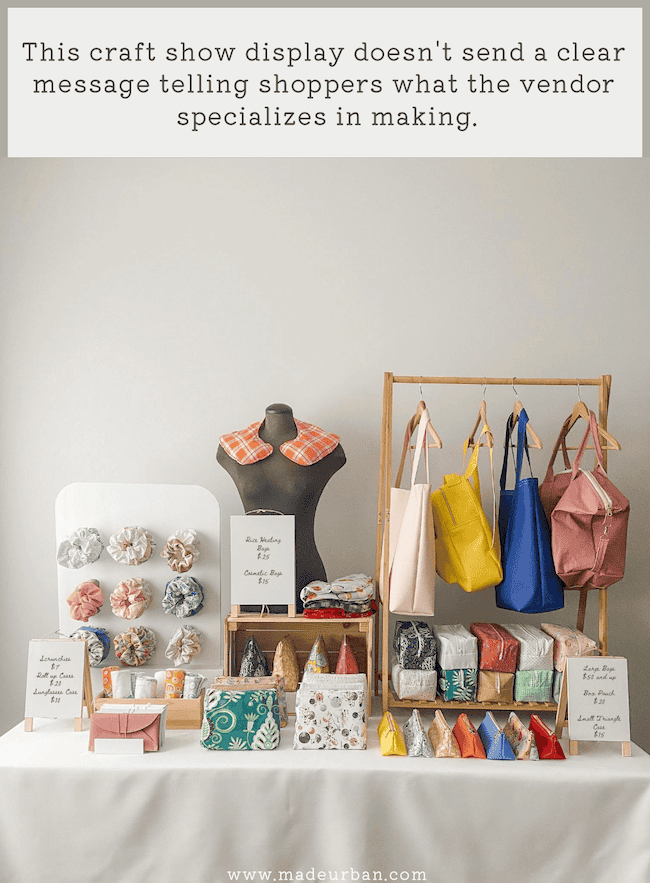
Craft show shoppers should be able to immediately define what type of “specialty store” you’re running.
Do you sell:
- Bath and body products?
- Pottery?
- Hair accessories?
- Jewelry?
- Bags?
What you sell may be defined by a category of product (e.g. bags) or subcategory of product (e.g. cosmetic bags). Often, the more you niche down, the clearer your “what” becomes.
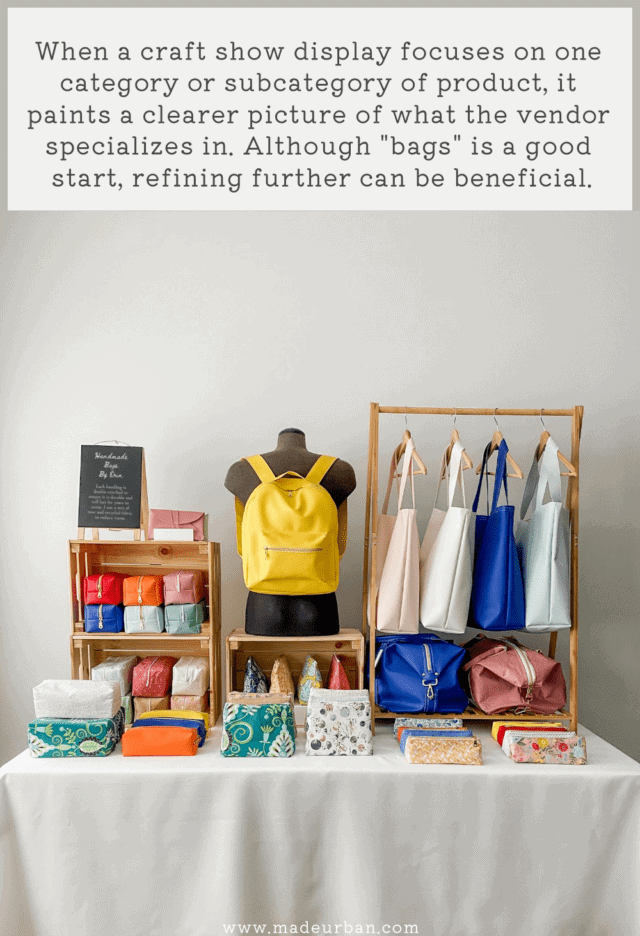
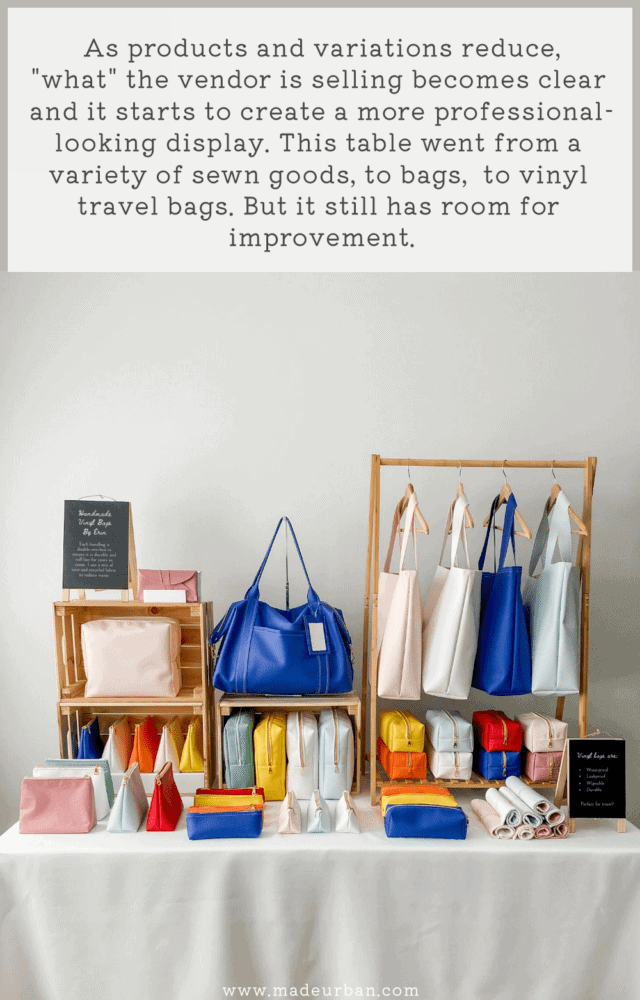
Or it may be defined by a specific purpose your products fulfill in your customers’ lives. For example, a vendor may sell items that fall under a variety of categories (e.g. bags, hair accessories, coffee mugs, etc.) but every item is for bachelorette parties.
A vendor selling too many types of products sends a confusing message. Are they a jewelry business? A home decor business? An accessory business? A soap business?
It’s okay for a big business or department store to check all those boxes. However, a small handmade business trying to check too many boxes will make a consumer question the quality of the products.
Imagine your ideal customer and how they might fill in the blanks:
I go to _________ (your business name) when I need the best _________ (what you sell).
2. Why you make it
Every business should serve a specific purpose.
Imagine another toilet paper brand showing up on grocery store shelves. Are you going to buy it if it looks identical to the brand you already know and trust and is the same price…or maybe even more expensive?
If a business is simply making the same type of items their competitors are, there’s no reason (in the consumer’s mind) to take a chance on an unknown business.
There must be a reason for a new business to exist, and shoppers must see and understand that reason if they’re going to buy.
>> Why does your business exist and why should shoppers buy from you?
>> What space are you filling in the marketplace and in your customers’ lives?
Again, if you’re offering too many styles and variations of your products, it muddies your message.
Focusing on a product feature, a niche, serving a different customer, etc. can create a strong “why” for your craft show table.
Bro Brick is one of my favourite (local) examples of a soap business with a good “why”.
When the majority of craft show soap vendors were selling bars of soap in floral or fruit scents and targeting women, Bro Brick featured soap scents, packaging, and branding that targeted men.
I first came across Bro Brick back in 2014, and as of writing this (2024), the business is still going strong. That shows the power of a strong “why”.
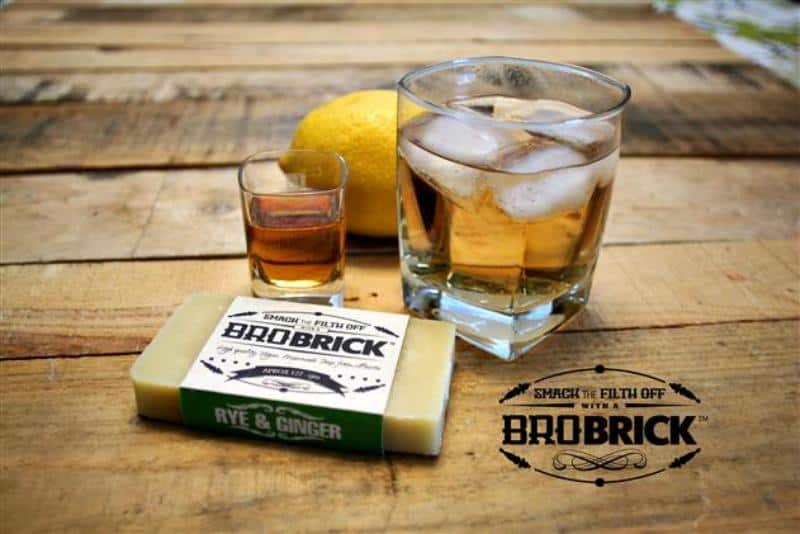
Bro Brick started their business with a unique angle.
But you don’t have to create something no one else is creating. You just need to be doing something that feels a little more special, or fitting, or different, than what consumers typically see.
Focus on a product feature
You’ve defined the type of product you specialize in; now consider the way in which your products are slightly different or better than your competitors.
Explore your product’s features, such as:
- materials/ingredients
- colors/prints
- production process
- benefits
- who it’s for
- etc.
Are there one or two product features you specialize in?
For example, when selling travel bags, I could focus on:
- A feminine color palette and fabric prints (colors/prints).
- Leakproof bags for airplane travel (benefit)
- Cosmetic bags for men (who it’s for).
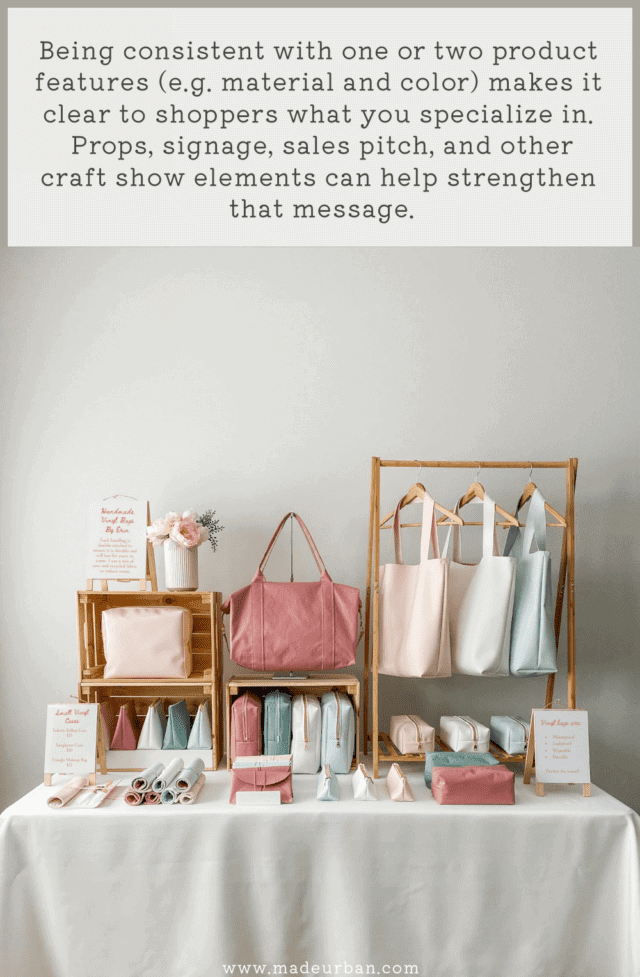
- A bath & body vendor may focus on using goat’s milk in the majority of their products (ingredients)
- A jewelry vendor may incorporate “love” gemstones into the majority of their pieces (materials)
- A vendor may make hair accessories that reduce hair breakage (benefit)
- A vendor may focus on creating throw pillows for children’s playrooms/bedrooms (who it’s for)
When the majority of your products incorporate that specific product feature, it helps communicate what you do differently.
Consider what makes your products slightly different or better than what your target market is used to seeing.
Highlight those products in your display and use signage/sales pitches to help communicate that message.
Feel free to share what you make and why you make it in the comments.

Hey, I’m Erin 🙂 I write about small business and craft show techniques I’ve learned from being a small business owner for almost 2 decades, selling at dozens of craft shows, and earning a diploma in Visual Communication Design. I hope you find my advice helpful!

I sell cookies that are all made from scratch and hand stirred for the person who wants to remember their childhood.
I sell jewelry and accessories handcrafted from repurposed vintage flatware, for the woman who isnt afraid to show her unique style, and appreciates the beauty of history.
I sell funky and easy-care monster stuffed animals for kids (of all ages) who love being cozy and silly.
I make clothing to fit the Build a Bear and friends from cute cotton fabrics for children .
I make pillowcases from cute cotton fabrics for children and those young at heart.
I make greeting cards and note cards. I purposely leave lots of room to write personal messages inside the greeting cards because I think a handmade card with a personal message is more than a card – it’s a gift. So much of our history has been preserved through personal letters and notes and future generations aren’t going to have that resource if we don’t start sharing our thoughts and adventures in writing, on paper.
I make jewelry and home decor for women who love history.
I design and create earth friendly fashion accessories from up-cycled items for stylish environmentally conscious people
Ray Kavhu (Zimbabwe)
I run a hand-crafted furniture business (Zim Master Woodkrafts) using recycled wood and traditional and Japanese joinery. Hand-crafting means that machine tools are used to the barest minimum. Most of the work is done with traditional hand tools.
Thank you so much for commenting everyone! I love hearing about your businesses and your descriptions are looking amazing 🙂 A few more tips to keep in mind:
-always try to speak your customer’s language to describe what you sell. For example, “easy care” may be updated to “washable” or “durable”
-consider what your customer is searching on Google or typing into the Etsy search bar. For example, someone who loves history may search for “heirloom style jewelry” or “historical replica jewelry”.
-try to describe WHO you sell to in the same way one might describe themselves, or the person they’re buying for. For example, someone who loves history might call themselves a “history buff”. Someone buying a pillowcase for a child would likely say “I’m looking for a pillowcase to fit into a 5-year-old girl’s room who loves princesses.”
I make Clay Pot People for the person that loves fun, unique and quirky items for their home or garden.
I make farmhouse-style textiles and lighting for those that live a busy life in the city, but seek the charm and simplicity of farmhouse living!
I sell personalized,rustic wood signs & home decor made from pallet wood and sliced logs or branches – perfect gifts for that hard-to-shop-for person who already has everything, wants for nothing, and is PROUD of who they are and what they do.
http://www.beyondbasicsdesign.com
I create hand-painted Mandala artwork full of color and vibrancy for those who want a unique, one-of-a-kind item that brightens up their home or homes of their friends and loved ones!
I make custom aprons for creative, and almost always messy, little artists and cook’s helpers….and for their grown-ups too!
I make authentic Native American jewelry (I’m NA) for the discriminating collector of Native art.
@tribalbydesign on Instagram. This article will help me tighten up my presence.
I create eco-friendly and active-living crochet designs to enrich the health of the planet and its inhabitants. @busy1izzy
I make heartshaped potholders, kitchen towel dresses, and pretty goat milk bar soap. I love the heartshaped potholders because they are easy to pick up off the counter and they are cute. I really like the kitchen towel dresses because the towel no longer falls off the stove handle and I chose the dress style because it is so feminine and unique. I like using pretty bar soap instead of the boring box store soap. Goat milk soap is so moisturizing and good for your hands that when I first tried it I was hooked. Bar soap can be used in the kitchen, or my towels can be used in the bathroom so they compliment each other.
I’ve found that each of the things I like about the 3 things I make are things other people like to because they have the same problem I struggled with.
Thanks for the informative article! I always look forward to reading them!
Kite Weather Shield skirts provide that “coat” layer for your legs. Wet weather? Wrap your legs in a Rain Skirt. Cool weather, chilly evenings, enjoying a beverage outside? Add a wrap around Warm Skirt with your jacket/sweatshirt. Winter cold and wind? Wrap around a Winter/Snow Skirt for warmth. Easy to wear over your clothes, the coat for your legs. For the Weather Warrior in all of us, wear a Kite Shield to protect your pants.
I make East care crocheted desert plants to decorate yours and your friends’ homes.
We create acrylic pour painted jewelry that is customizable for a truly unique look to complete any outfit while minimizing product waste from our painting projects.
I make suncatchers and hanging mobiles from repurposed materials like chandelier crystals, vintage jewelry, lamp parts, and even branches. https://www.etsy.com/shop/ScrapArtCrone
I make personal care products using botanical-infused oils for persons looking for effective personal care without all the chemicals.
I make hand-made cards to help my customers spread joy via handwritten notes. But, I find that craft shows are a waste of time. My goal is to spread happiness, but it would be nice to break even once in a while (simply recovering the fee I paid to get my work into the show).